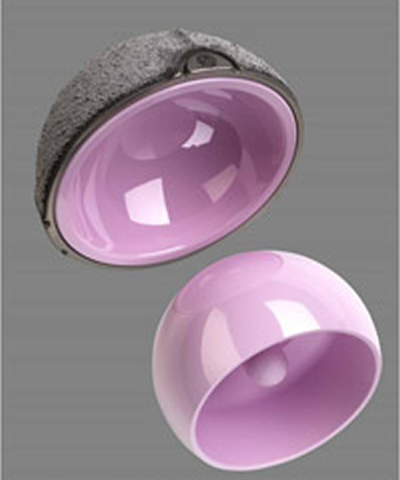What is Hip Resurfacing?
Hip resurfacing was developed to treat painful arthritis in young and active patients.
In a total hip replacement the damaged socket (the acetabulum) and the damaged ball (the head of the femur) are both removed and replaced by metal, plastic or ceramic components. In contrast, in hip resurfacing the damaged SURFACES are cleaned up and replaced. So the socket in the pelvic bone is cleaned and a liner or steel placed in the cavity, and the damaged head of the femur is cleaned up and covered by a thin shell of steel too - hence "resurfacing".

This is a good example of the implants I use

An x-ray of a hip joint after resurfacing
Hip resurfacing has particular value if you are young or active. Although extremely tough and strong any replacement joint has got a certain "lifespan" and will wear out over maybe 20 or so years. This is not so important if you are older when you have a hip replacment - because the replacement joint will outlast you so to speak!
But if you have hip arthritis in your late forties or early fifties, then your replacement joint will likely wear out and need replacing whilst you are in your 60s or 70s. Replacing a worn out hip replacement is a significant operation and can be quite complex. However replacing a resurfaced hip joint is easier and more straitforward.
We offer hip resurfacing in Southampton as an alternative to total hip replacement surgery. It is now an established technique and the results for carefully selected patients are usually excellent – in some ways better than the results of total hip replacement.
The Benefits of Hip Resurfacing
Reduced risk of dislocation
Dislocation is one of the most common complications of hip replacement, and it’s a problem that is virtually eliminated with hip resurfacing. Most patients who have had hip resurfacing surgery return to work and sports within a few months of surgery.
No need to remove the head of the femur
Hip resurfacing is as the name suggests – a re-surfacing of the hip joint. Unlike with a total hip replacement, the head of the femur is preserved rather than removed. This makes it easier to replace if it is necessary at a later date.
Revisions are often easier
If you have a total hip replacement when you are young, you may find that the hip eventually wears out. If you are particularly active or wish to play sports, your replacement hip will wear out faster. Revision surgery might be needed, but it can be quite an undertaking. Hip resurfacing was developed to delay the need for major revision surgery, and for many patients this has been the case.
Hip resurfacing surgery is now an established technique which provides an excellent solution for many patients. We tend to use it in younger active men where the long term results are excellent. There have been problems with some types of hip resurfacing devices, which has made many surgeons reluctant to use this technique. Some devices were withdrawn from the market, but we use one which has over 10 years history and excellent results for carefully selected patients.
Materials used in Hip Resurfacing
Resurfacings are made from the tough metal alloy chrome cobalt molybdenum for its durability. You may be aware of concerns about the effects of long-term exposure to chromium and cobalt. While it’s true that high concentrations of these elements can damage cells or cause allergic reactions, there is no evidence that resurfacings are harmful to health in the longer term. We hope to be able to use the ceramic ReCerf when it receives regulatory approval in 2020.
Hip Resurfacing in Southampton
If you would like to discuss whether hip resurfacing could be an appropriate operation for you, please contact our surgeon, Jeremy Latham.

